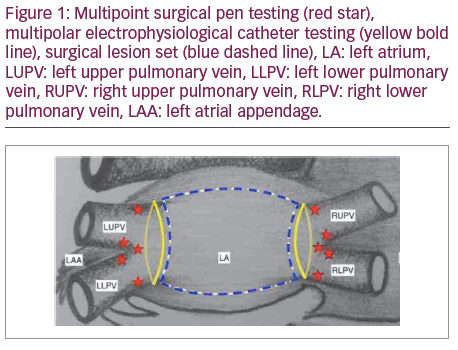Background: Thoracoscopic surgical ablation (TSA) has recently emerged as an alternative to catheter ablation for atrial fibrillation (AF) with higher single procedure success rates. Electrophysiological conduction testing is key to achieve the best outcome for TSA. Two-step conduction block testing using surgical pen testing followed by multipolar electrophysiological catheter testing has been shown to be more robust when compared to surgical pen testing alone to assess electrical conduction block during TSA in long standing persistent AF (LSPAF). However, surgical pen testing is generally placed in only a few test points to test entrance and exit block whereas multipolar catheter testing is done at multiple sites in a single attempt. Multipolar electrophysiological catheter may not always be feasible due to combination of anatomical limitations and technical challenges. Therefore, we sought to compare multipolar electrophysiological catheter testing against surgical pen testing at multiple points during TSA.
Methods: Eleven de-novo LSPAF patients underwent TSA. All pulmonary veins (PV) underwent pre-ablation testing using a surgical pen (Atricure). Post ablation, PV isolation was evaluated by multi-point surgical pen testing at 10 sites per patient (Figure 1), resulting in five sites per PV. If PV appeared silent, multipolar electrophysiological catheter (Figure 1) was wrapped around the PV to test for circumferential isolation. The catheter has 20 electrodes/poles therefore 10 distinct sites per PV.
Results: Of the 11 patients, only eight underwent multipolar electrophysiological catheter testing. One patient was converted to catheter ablation due to adhesions. Two patients had enlarged superior vena cavae and therefore were high risk to attempt multipolar electrophysiological catheter testing. Of the eight patients, mean age was 64 ± 7 years and 62.5% were male. Almost a third of the patients (62.5%) are hypertensive, with an average left atrial diameter of 48 mm (± 4 SD) and an average left ventricular ejection fraction of 58% (± 8 SD). All 32 PV from eight patients were connected pre-ablation.
Post-ablation, all 80 surgical pen sites showed PV isolation with multipolar electrophysiological catheter testing identifying only one additional site (1.25%) of PV reconnection.
Conclusion: Our data shows that the surgical pen provides robust conduction block assessment when testing at multiple points and is comparable to multipolar electrophysiological catheter testing. The surgical pen is also compatible with a wider range of patient anatomies than the multipolar electrophysiological catheter and is technically less demanding. Multipoint surgical pen testing takes less time and hence makes the TSA procedural workflow more efficient. The surgical pen is multi-purpose and during the procedure is used to ablate, pace and sense. Finally, just using the surgical pen at multiple sites has a cost benefit, due to the additional cost (£600) of the multipolar electrophysiological catheters whereas the surgical pen is a mandatory requirement for ablation in TSA procedure.








